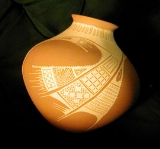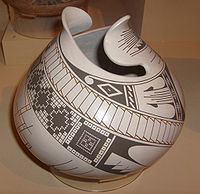
Mata Ortiz
Encyclopedia
Mata Ortiz is a small village in the state
of Chihuahua, Mexico, less than 100 miles (160.9 km) from the US-Mexico border. The community, population 2,000, is one of the designated localidades (localities) in the municipio libre (municipality)
of Casas Grandes
, one of several such pueblos in a wide, fertile
valley
long inhabited by indigenous people. Mata Ortiz is located at the base of a mountain known as El Indio and on the west bank of the Rio Palanganas, a tributary of the Rio Casas Grandes. The ancient ruins of Casas Grandes
are located nearby.
and Arizona
and throughout northern Mexico, modern potters are producing work for national and international sale. This new artistic movement is due to the efforts of Juan Quezada, the self-taught originator of modern Mata Ortiz pottery, his extended family and neighbors.
 Mata Ortiz pots are hand built without the use of a potter’s wheel. Shaping, polishing and painting the clay is entirely done by hand, often with brushes made from children’s hair. All materials and tools originate from supplies that are readily available locally. The preferred fuel for the low temperature firing is grass-fed cow manure or split wood. Each of these characteristics derive from the ancient pottery traditions of the region, however Mata Ortiz ware incorporates elements of contemporary design and decoration and each potter or pottery family produces distinctive individualized ware.
Mata Ortiz pots are hand built without the use of a potter’s wheel. Shaping, polishing and painting the clay is entirely done by hand, often with brushes made from children’s hair. All materials and tools originate from supplies that are readily available locally. The preferred fuel for the low temperature firing is grass-fed cow manure or split wood. Each of these characteristics derive from the ancient pottery traditions of the region, however Mata Ortiz ware incorporates elements of contemporary design and decoration and each potter or pottery family produces distinctive individualized ware.
Young clay workers from surrounding areas have been attracted to the Mata Ortiz revival and have joined Quezada and his associates. New potting families developed and the art movement continues to expand. A vibrant flow of new ideas, without the restraints of traditional practices or gender constraints, has enabled the pottery of Mata Ortiz to avoid derivative repetition common to folk art movements. This blend of cultural expression, economic need and artistic freedom has produced a unique artistic movement in the community.
visited Mata Ortiz and met Juan Quezada and his extended family of brothers, sisters, their children and neighbors. This group of artisans are the core of this now thriving pottery movement. Information published after this and later visits quickly promoted the acceptance of Mata Ortiz pottery as a contemporary art form. This simple pottery is accepted and admired as a legitimate folk art, and has become highly collectable.
 An exhibit of twenty pots from Mata Ortiz went on display at the Field Museum of Natural History
An exhibit of twenty pots from Mata Ortiz went on display at the Field Museum of Natural History
in Chicago
, United States
, on July 1, 2005. The exhibit allows visitors to see the different styles of the artists, and includes a short video about the town. The exhibit was on display until May 31, 2006.
The American Museum of Ceramic Art, in Pomona, California
, sponsored an exhibit of pottery from Mata Ortiz between June 9th and August 25th, 2007. In conjunction with the exhibit, a demonstration workshop on June 10th featured Juan Quezada, his son Noe Quezada, and Diego Vallez. Demonstrations included pot formation, decoration and firing methods. There have been various exhibits of Mata Ortiz pottery in Arizona, Colorado, New Mexico and California The most recent exhibit was in Washington, D.C. August-October, 2009.
States of Mexico
The United Mexican States is a federal republic formed by 32 federal entities .According to the Constitution of 1917, the states of the federation are free and sovereign. Each state has their own congress and constitution, while the Federal District has only limited autonomy with a local Congress...
of Chihuahua, Mexico, less than 100 miles (160.9 km) from the US-Mexico border. The community, population 2,000, is one of the designated localidades (localities) in the municipio libre (municipality)
Municipalities of Mexico
Municipalities are the second-level administrative division in Mexico . There are 2,438 municipalities in Mexico, making the average municipality population 45,616...
of Casas Grandes
Casas Grandes, Chihuahua
Casas Grandes is a town located in the northern Mexican state of Chihuahua. It serves as the municipal seat of government for the surrounding Casas Grandes Municipality of the same name....
, one of several such pueblos in a wide, fertile
Fertile soil
Fertile soil has the following properties:*It is rich in nutrients necessary for basic plant nutrition, including nitrogen, phosphorus and potassium....
valley
Valley
In geology, a valley or dale is a depression with predominant extent in one direction. A very deep river valley may be called a canyon or gorge.The terms U-shaped and V-shaped are descriptive terms of geography to characterize the form of valleys...
long inhabited by indigenous people. Mata Ortiz is located at the base of a mountain known as El Indio and on the west bank of the Rio Palanganas, a tributary of the Rio Casas Grandes. The ancient ruins of Casas Grandes
Casas Grandes
Casas Grandes is the contemporary name given to a pre-Columbian archaeological zone and its central site, located in northwestern Mexico in the modern-day Mexican state of Chihuahua. It is one of the largest and most complex sites in the region...
are located nearby.
Pottery movement
Mata Ortiz has recently seen a revival of an ancient Mesoamerican pottery tradition. Inspired by pottery from the ancient city of Paquimé, which traded as far north as New MexicoNew Mexico
New Mexico is a state located in the southwest and western regions of the United States. New Mexico is also usually considered one of the Mountain States. With a population density of 16 per square mile, New Mexico is the sixth-most sparsely inhabited U.S...
and Arizona
Arizona
Arizona ; is a state located in the southwestern region of the United States. It is also part of the western United States and the mountain west. The capital and largest city is Phoenix...
and throughout northern Mexico, modern potters are producing work for national and international sale. This new artistic movement is due to the efforts of Juan Quezada, the self-taught originator of modern Mata Ortiz pottery, his extended family and neighbors.

Young clay workers from surrounding areas have been attracted to the Mata Ortiz revival and have joined Quezada and his associates. New potting families developed and the art movement continues to expand. A vibrant flow of new ideas, without the restraints of traditional practices or gender constraints, has enabled the pottery of Mata Ortiz to avoid derivative repetition common to folk art movements. This blend of cultural expression, economic need and artistic freedom has produced a unique artistic movement in the community.
Reception as an art form
In 1976, anthropologist Spencer MacCallumSpencer MacCallum
Spencer Heath McCallum , commonly known as Spencer MacCallum, is an American anthropologist, business consultant and libertarian anarchist author...
visited Mata Ortiz and met Juan Quezada and his extended family of brothers, sisters, their children and neighbors. This group of artisans are the core of this now thriving pottery movement. Information published after this and later visits quickly promoted the acceptance of Mata Ortiz pottery as a contemporary art form. This simple pottery is accepted and admired as a legitimate folk art, and has become highly collectable.
Exhibits, displays and demonstrations

Field Museum of Natural History
The Field Museum of Natural History is located in Chicago, Illinois, USA. It sits on Lake Shore Drive next to Lake Michigan, part of a scenic complex known as the Museum Campus Chicago...
in Chicago
Chicago
Chicago is the largest city in the US state of Illinois. With nearly 2.7 million residents, it is the most populous city in the Midwestern United States and the third most populous in the US, after New York City and Los Angeles...
, United States
United States
The United States of America is a federal constitutional republic comprising fifty states and a federal district...
, on July 1, 2005. The exhibit allows visitors to see the different styles of the artists, and includes a short video about the town. The exhibit was on display until May 31, 2006.
The American Museum of Ceramic Art, in Pomona, California
Pomona, California
-2010:The 2010 United States Census reported that Pomona had a population of 149,058, a slight decline from the 2000 census population. The population density was 6,491.2 people per square mile...
, sponsored an exhibit of pottery from Mata Ortiz between June 9th and August 25th, 2007. In conjunction with the exhibit, a demonstration workshop on June 10th featured Juan Quezada, his son Noe Quezada, and Diego Vallez. Demonstrations included pot formation, decoration and firing methods. There have been various exhibits of Mata Ortiz pottery in Arizona, Colorado, New Mexico and California The most recent exhibit was in Washington, D.C. August-October, 2009.
Books
- Cahill, Rick. "The Story of Casas Grandes Pottery." Bodjum Books, 1991, ISBN 0-9630853-0-1
- Lowell, Hills, Quintana, et al., The Many Faces of Mata Ortiz, Rio Nuevo Publishers, Tucson, AZ, 1999; ISBN 1-887896-08-2 - an overview of many of the Mata Ortiz potters and their individual styles.
- Parks, Walter, The Miracle of Mata Ortiz, The Courier Press, Riverside, CA, 1994; ISBN 0-9637655-0-7 - outlining the history of Mata Ortiz pottery.
External links
- Mata Ortiz Calendar, maintained by Spencer and Emalie MacCallum. Links to photos of Mata Ortiz pottery, information on travel & tours, news, exhibits and other events related to the village of Mata Ortiz and Mata Ortiz pottery.
- The Renaissance of Mata Ortiz, documentary on Mata Ortiz pottery.
- Mata Ortiz Pottery: A Forty-Year Phenomenon at the American Museum of Ceramic Art, June 9 - August 25, 2007.

